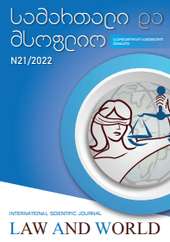The Role of the Individual Assessment Report in Determining the Best Interest of a Juvenile Before Sentencing (Case law Analysis) 
##plugins.themes.bootstrap3.article.main##
Abstract
The importance of the scientific paper is due to the combined theoretical and practical analysis of the norm-principles of juvenile justice and the report of individual evaluation; in particular, the study of case law. The research uses the method of analysis and comparison, the method of logical reasoning and reasoning, the method of studying and generalizing specific criminal cases and established judgments. The structure of the paper is a kind of chain that is logically related to each other, which is consequently reflected in the sentencing of a judge. In particular, it analyzes what is meant and how to prioritize the best interest before the judge imposes a sentence, then logically links it to the principle of individual approach to the juvenile, which is also inherent in juvenile justice and the principle of best interest priority. These norms find practical viability in an individual assessment report, in particular, the paper discusses in detail what issues a social worker will explore before sentencing a juvenile. An individual assessment report within juvenile justice is the basis for a combination of outlining principles and making decisions tailored to the best interests of the juvenile. After taking into account a number of circumstances analyzed in the individual assessment report, the judge will have a clear idea of what will be the best decision for the juvenile to re-socialize-rehabilitate.
##plugins.themes.bootstrap3.article.details##
Section
Articles
How to Cite
The Role of the Individual Assessment Report in Determining the Best Interest of a Juvenile Before Sentencing (Case law Analysis). (2022). Law and World, 8(21), 136-158. https://doi.org/10.36475/8.1.8
How to Cite
The Role of the Individual Assessment Report in Determining the Best Interest of a Juvenile Before Sentencing (Case law Analysis). (2022). Law and World, 8(21), 136-158. https://doi.org/10.36475/8.1.8


